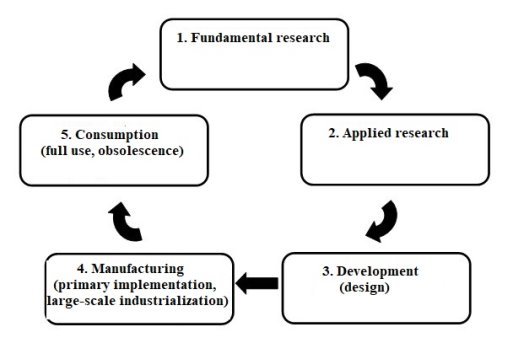«Innovation» and «Innovation process»: theoretical aspect
Автор: Пушнова Валерия Валерьевна
Рубрика: 1. Информатика и кибернетика
Опубликовано в
Дата публикации: 29.11.2019
Статья просмотрена: 178 раз
Библиографическое описание:
Пушнова, В. В. «Innovation» and «Innovation process»: theoretical aspect / В. В. Пушнова. — Текст : непосредственный // Технические науки: традиции и инновации : материалы IV Междунар. науч. конф. (г. Санкт-Петербург, январь 2020 г.). — Санкт-Петербург : Свое издательство, 2020. — С. 3-6. — URL: https://moluch.ru/conf/tech/archive/356/15475/ (дата обращения: 25.04.2024).
The author discusses the topical concepts of “innovation” and “innovation process”, providing an overview of the development of the concept of “innovation” in the historical context, and presents a scheme of the innovation life cycle consisting of five main stages.
Keywords: innovation, innovation process, innovation life cycle.
In the modern world with its heightened competitiveness demands, countries are forced to create and produce increasingly new technologies and products in any area of society’s activity. Such new technologies and products must meet the requirements of the times and they constitute “innovation”, the process of creating “innovation” being defined as “innovation process”.
Many different scientists have been engaged in research in the field of innovation — economists, engineers, managers, control system specialists, sociologists, educators, psychologists, culture experts, including: M. I. Tugan-Baranovsky (Industrial Crises, 1900), J. Schumpeter (The Theory of Economic Development, 1911; Business Cycles, 1939), V. Lopatin (The Specifics of the Contradictions of the Innovation Process, 1985), P. Drucker (Innovation and Entrepreneurship, 1985), A. I. Prigozhin (Innovation: Incentives and Obstacles, 1989), B. Santo (Innovation as a Means of Economic Development, 1990.) and others [1, 2, 3, 4].
The very concept of “innovation” appeared a relatively long time ago, but it was not until the twentieth century that it became a separate area of research. History indicates that the concept of “innovation” was initially used in the nineteenth century in the scientific research of culture experts and meant the process of introducing elements of one culture into another. At the beginning of the twentieth century, in the period of the scientific and technological process, with the development of material production, the concept of “innovation” began to be considered as a technical innovation. At the same time, the concept of «innovation» was presented in studies as a process of introducing changes into production equipment and technology. A significant historic step in the development of the concept of “innovation” took place in the 1930s due to the development of the theoretical foundations by the Russian scientist N. D. Kondratiev (1892–1938), the author of the world-famous theory of “major cycles” or “long waves” in economics. Kondratiev formulated the idea of major cycles or waves lasting 50 years associated with technological innovation. Based on the statistical material covering a range of 140 years, the scientist established the influence of technological innovations on the global industrial production and proved that a technological wave reaches its maximum every 50 years. His theory demonstrated that each primary innovation causes many secondary changes, such as a change in industrial production, a change in the economic structure of the market, a change in the social sphere of needs and services. Thus, Kondratiev’s theoretical foundations of innovation not only covered technology but also indicated its connection to economy and sociology.
Russian and Western scientists further successfully developed Kondratiev’s theory, applying it in their research of innovation, in particular in systems for analyzing long-term economic dynamics of innovation and determining the key factors of economic growth or economic crisis.
Of the many existing definitions of the concept of “innovation” proposed by various scientists, we single out the modern generalized definition given by B. F. Usmanov: “Innovation is a product of human-driven development, which is purposefully used by society and its structures to achieve progress in one or another area of life” [4, p. 35].
One of the following issues directly related to the concept of “innovation” is “innovation process”. It is clear that the creation of innovation had to have a certain procedure from the first step — the investigated “idea” — to the last one — “consumption” by society. And this procedure was defined as “innovation process”.
“Innovation process is a systemic organized set of sequentially carried out types of productive activity” [1, p.26].
The innovation process can consist of many steps or stages, such as the emergence of an idea, theoretical research, studying the demand of the target audience, describing the idea in the form of a practical project, developing a technology for creating the product, studying the sales market, studying the competitiveness of the product, selling the product as consumer goods for the target consumer audience (see example in Fig. 1) [5].

Fig. 1. Innovation process
But today, five main stages of the innovation process are distinguished, defined as the “life cycle of innovation”:
- fundamental research;
- applied research;
- development (design);
- manufacturing (primary implementation, large-scale industrialization);
- consumption (full use, obsolescence).

Fig. 2. A life cycle of innovation
Fig. 2 shows the diagram of an innovation life cycle consisting of five main stages [1, p. 28]. Each of the stages of the cycle requires careful practical study and technical approach, since the success of the innovation process depends on it. The whole procedure of the innovation process should be adaptive to emerging economic needs, since the profitability of the innovation process depends on it.
Since the concept of “innovation” turned out to be multidisciplinary, covering many areas of science, it required a separate subject area presented today as “innovation studies”. “Innovation studies is a branch of science and practice that explores the role and place of innovation, the creative and organizational potential of its creators (innovators) in the processes of controlled development, the specifics of qualitative changes in the products of human activity in the course of the implementation of socially useful innovation” [4, p. 37]. This subject area deals with such issues as the formation of innovations, modeling of innovation processes, organization and management of innovation activities, etc. A consistent study of all issues of the subject area will expand the boundaries of knowledge of “innovation” and “innovation processes”, making them more successful and profitable, and thereby making it possible to increase the level of technical, economic and social development of society.
References:
- Darmilova Zh.D. Innovation Management: A manual for bachelor degree students. Moscow: Dashkov and Co. Publishing and Trading Corporation, 2013.168 p. ISBN 978–5-394–02123–7 (in Russian)
- Makaruk O. E. The concept of “innovation”: theoretical aspect // http://elib.bsu.by/bitstream/123456789/141807/1/makaruk_sbornik15.pdf Accessed 19 November 2019 (in Russian)
- Tchaikovskaya N. V., Panyagina A. E. The essence of innovation: basic theoretical approaches // (https://cyberleninka.ru/article/n/suschnost-innovatsiy-osnovnye-teoreticheskie-podhody) Accessed 19 November 2019 (in Russian)
- Usmanov B. F. Social Innovation: Textbook. M.: Sotsium, 2009. 518 p. ISBN 978–5-98079–310–4 (in Russian)
- Electronic resource, Access mode: https://www.shutterstock.com/tr/search/research-development?image_type=illustration&search_source=base_related_searches
Похожие статьи
Зачем нам нужен ISBN? — Молодой ученый
ISBN – это уникальный номер книги. В теории, каждое книжное издание в мире имеет свой, неповторимый, номер ISBN. Не каждый экземпляр, конечно, а именно книжное издание...
Спецвыпуски журнала — Молодой ученый
Спецвыпуск — это отдельная часть журнала, которая издается специально по вашему заказу. В спецвыпуск попадут только те статьи, которые вы отобрали. Статьи будут размещены на...
“Feminism philosophy” from French Revolution to present time
The evolution of international human rights. University of Pennsylvania Press. pp.18–20. ISBN 978–0-8122–1854–1. Naish, Camille (1991). Death comes to the maiden: Sex and Execution, 1431–1933.
The Theatre of the Absurd in Sam Shepard’s Early Plays
Расшифровывается ISBN как International Standard Book Number, то есть «международный стандартный номер книги». Educational positive management: features and recommendations.
Роль книги в жизни современного школьника | Статья в журнале...
Зачем нам нужен ISBN? — Молодой ученый. ISBN – это уникальный номер книги. В теории, каждое книжное издание в мире имеет свой, неповторимый, номер ISBN.
Creative Technologies in Foreign Language Teaching | Молодой ученый
— Молодой ученый. Расшифровывается ISBN как International Standard Book Number, то есть «международный стандартный номер книги».
Negative consequences of natural disasters in Khorezm region
ISBN – это уникальный номер книги. В теории, каждое книжное издание в мире имеет свой, неповторимый, номер ISBN. Не каждый экземпляр, конечно, а именно книжное издание...
Teaching speech etiquette in English lessons | Статья в журнале...
Расшифровывается ISBN как International Standard Book Number , то есть «международный стандартный номер книги». Материалы VII международной научной конференции «Экономика...»
Парадигма «Модель структуры знаний в архитектурной...»
ISBN 978–5-9227–0311–6. 2. Архитектурный дизайн (функциональные и художественные основы проектирования): Учебн. пособие — М.: Архитектура-С, 2006.
Зарубежный опыт развития малого и среднего...
На современном этапе развития национальной экономики приоритетное значение отдается развитию и стимулированию малого и среднего предпринимательства. Таким образом, в...
Похожие статьи
Зачем нам нужен ISBN? — Молодой ученый
ISBN – это уникальный номер книги. В теории, каждое книжное издание в мире имеет свой, неповторимый, номер ISBN. Не каждый экземпляр, конечно, а именно книжное издание...
Спецвыпуски журнала — Молодой ученый
Спецвыпуск — это отдельная часть журнала, которая издается специально по вашему заказу. В спецвыпуск попадут только те статьи, которые вы отобрали. Статьи будут размещены на...
“Feminism philosophy” from French Revolution to present time
The evolution of international human rights. University of Pennsylvania Press. pp.18–20. ISBN 978–0-8122–1854–1. Naish, Camille (1991). Death comes to the maiden: Sex and Execution, 1431–1933.
The Theatre of the Absurd in Sam Shepard’s Early Plays
Расшифровывается ISBN как International Standard Book Number, то есть «международный стандартный номер книги». Educational positive management: features and recommendations.
Роль книги в жизни современного школьника | Статья в журнале...
Зачем нам нужен ISBN? — Молодой ученый. ISBN – это уникальный номер книги. В теории, каждое книжное издание в мире имеет свой, неповторимый, номер ISBN.
Creative Technologies in Foreign Language Teaching | Молодой ученый
— Молодой ученый. Расшифровывается ISBN как International Standard Book Number, то есть «международный стандартный номер книги».
Negative consequences of natural disasters in Khorezm region
ISBN – это уникальный номер книги. В теории, каждое книжное издание в мире имеет свой, неповторимый, номер ISBN. Не каждый экземпляр, конечно, а именно книжное издание...
Teaching speech etiquette in English lessons | Статья в журнале...
Расшифровывается ISBN как International Standard Book Number , то есть «международный стандартный номер книги». Материалы VII международной научной конференции «Экономика...»
Парадигма «Модель структуры знаний в архитектурной...»
ISBN 978–5-9227–0311–6. 2. Архитектурный дизайн (функциональные и художественные основы проектирования): Учебн. пособие — М.: Архитектура-С, 2006.
Зарубежный опыт развития малого и среднего...
На современном этапе развития национальной экономики приоритетное значение отдается развитию и стимулированию малого и среднего предпринимательства. Таким образом, в...











